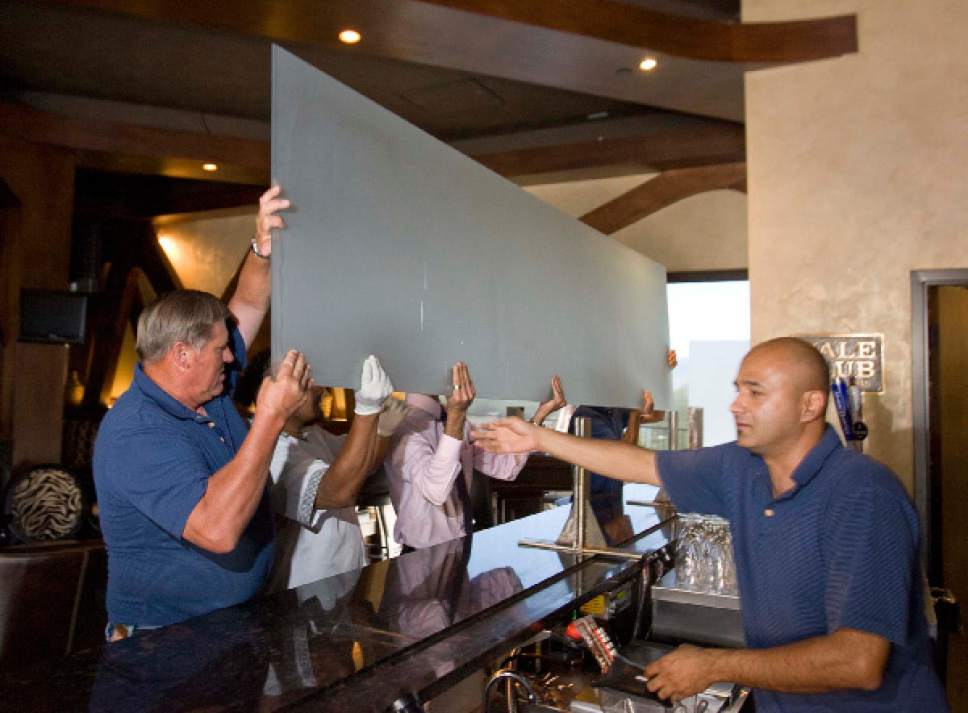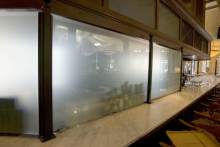This is an archived article that was published on sltrib.com in 2017, and information in the article may be outdated. It is provided only for personal research purposes and may not be reprinted.
The Utah House on Friday passed an alcohol reform bill aiming to at least partially quench the thirst to eliminate the much-maligned "Zion Curtain," the 7-foot-tall barrier to prevent children from seeing drinks mixed in restaurants.
HB442, as amended, would allow restaurants with bars several options besides the Zion curtain: put the bar in a separate room; create a buffer area banning children within 10 feet of the bar; or build a 42-inch-high railing or half-wall to delineate the boundary between a no-kids-allowed bar zone and the dining area.
The House passed it 58-10, and sent it to the Senate for more consideration.
"I think we are improving our liquor policy in many ways," said the bill's sponsor, House Majority Leader Brad Wilson, such as reforms targeting underage drinking and overconsumption. "I think we are seeing broad-based support for this. I don't think everyone got what they wanted."
The section of the bill receiving the most attention is the Zion Curtain.
Wilson said Utah now offers many different licenses — and rules — for restaurants with bars. Newer ones that opened since a liquor law reform passed in 2009 must have Zion Curtains. Older "grandfathered" restaurants do not. Dining clubs also do not need them, and are allowed to have a higher percentage of sales from liquor.
The bill would make all restaurants face the same regulations by 2022, Wilson said, giving them time to phase in improvements or changes. "It puts every one on the same level playing field," he said. And, "I don't believe children should be next to a bar."
Wilson said his bill now is supported by state and city restaurant associations. But some individual restaurants have said it may cost them big money to remodel if they want to stay in business. Others say they are so small or have unusual shapes that may prohibit adding buffer areas.
House Speaker Greg Hughes told the GOP Caucus that he is amazed that lawmakers are being criticized for not simply dumping Zion Curtains, and for trying to keep children away from bar areas.
He said where he was raised in Pennsylvania, "that would be considered a courtesy to the people at the bar" who do not want the noise and bother of nearby kids. "It's not a Chuck E. Cheese, OK?"
Wilson added that at least 15 other states have buffer zones or similar requirements that would be in the new legislation.
Rep. Patrice Arent, D-Millcreek, complained that Utah law bases its requirements for barriers and buffers on the premise that "it is dangerous and a problem if children watch drinks being mixed." She said she has asked for data to prove it, and has never seen any.
She said the idea makes no sense, especially because children can watch their parents and people at other tables drink while dining. She still supported the bill, saying it is an improvement over current law.
Rep. Mike Noel, R-Kanab, said his father was an alcoholic. He said seeing drinks did fascinate him as a child, and said it helped lead him to drink (but he later quit) and contributed to some of his siblings becoming alcoholics. "Don't allow children to get enamored by it."
The bill has many other key changes, including:
• Increasing the state markup on liquor by 2 percentage points, from 86 percent to 88 percent, to fund new training and prevention programs. The markup on heavy beer sold in liquor stores would go up from 64.5 percent to 66.5 percent.
• Requiring grocery and convenience stores to keep all alcoholic drinks in no more than two areas, with signs saying clearly that they contain alcohol. Wilson said some such drinks have been put next to kids foods and drinks — and have been mistaken for soda because printing warning that it was alcoholic was so small.
• Creating new underage drinking prevention programs for youth in eighth and 10th grades.
• Creating new training programs for owners and employees about liquor law as they renew licenses, or every three years.
• Shortening the minimum distance from a restaurant with a bar and schools, churches, parks or libraries. Now it is 600 feet by the shortest legal pedestrian route. It would drop to 450 feet. The law also would not allow approval of any variances as in the past.
Gov. Gary Herbert earlier this week also supported the bill — and predicted it may just be one step toward totally eliminating the Zion Curtain here.
"I suspect that over time, the preparation wall is going to cease to exist," he told reporters on Thursday.
When asked if he believes seeing drinks mixed makes children more likely to drink, the governor said, "I don't think there's any data one way or the other. It's kind of a hunch people have, a perception people have, but it's not based on any scientific data…. I think that's been the big problem."





